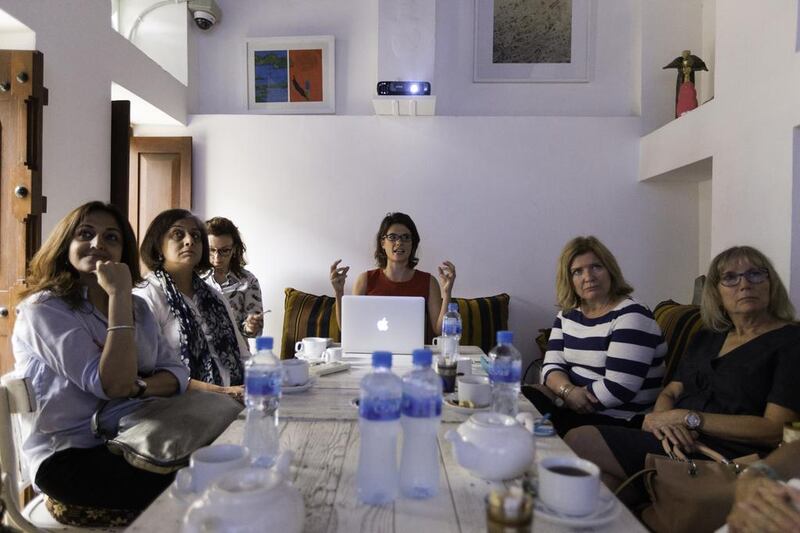As any good storyteller will tell you, the devil is in the details.
Rose Balston, an art historian and lecturer who began a series of lectures this week covering the cultural connections between the Middle East and Europe in art across centuries, trains her audience eyes to hone in on aspects of artworks they might otherwise not notice.
During the first part of her lecture she showed an image of Hans Holbein's 1537 work The Whitehall Mural, featuring King Henry VIII of England with his Queen, Jane Seymour, and his parents, Henry VII and Elizabeth of York. The image is typical of works from this period, with the royals in stately robes, standing in dignified poses – but Balston also drew attention to what was under their feet: a sprawling, opulent Persian carpet.
According to Balston, an engaging speaker full of knowledge, Henry VIII was obsessed with these luxurious carpets and went out of his way to fill his palaces with them, even though they were so expensive at the time that each one would have cost as much as a battleship.
In the Holbein painting, the size of the carpet symbolises the king’s stature. “Carpets have always signified wealth,” says Balston. “They are fabulous pieces of art, and the fact that you have so much that you can walk on something this special, shows the extent of your wealth.”
This is just one of the symbols that Balston pointed out in her lecture, during which she used the carpet as a jumping-off point for a discussion about the robust trading between the Middle East and Europe. She also gave key insights into how to read art, particularly from the Renaissance period.
To contextualise all of this, she gave a visual tour of Venice, the most important trading hub in Europe from the 14th to the 16th centuries. Pointing out the influence from the East in the city’s architecture, and other details, she highlighted the clear impact that such trade had during this time. “Without the relationship with the East, Venice would have stayed as a small fishing village,” she says.
Using carpets as a motif to show not only produce but also art and culture were being transferred through the trading routes, she went on to point out the different ways in which artists used floor coverings to send a message to their viewers.
In a painting of the nine-year-old heir to Henry’s rule, Edward VI, she pointed out the creased Oriental carpet on which he was standing – symbolic of the threat posed by the Ottoman Empire at the time.
Balston also discussed Gentile Bellini, a Venetian who went to live in Constantinople to advise the rulers on their art collections, as well as Carlo Crevelli, another Italian painter who used carpets in his paintings to draw the viewer’s eye across the most important elements of his work.
“To sum up, it was the carpet, a cultural artefact, that was a binding point between the East and the West – and even today, we still have art bringing these great continents together,” she says.
The second part of her lecture shifted the focus to the 19th century and Victorian England. Describing the historical references after the advent of the steamboat, Balston charted the way artists travelled to the Middle East and found inspiration there for their paintings.
“The Victorians were great travellers and wanted to explore all corners of the globe,” she says. “The Middle East was extremely popular, and particularly in the midst of Darwinism because people wanted to travel to the region to reaffirm their faith.”
She focused on three artists, William Holman Hunt, John Frederick Lewis and Frederic Leighton, all of whom had different reasons for travelling, which were reflected in their paintings.
Balston touched on important themes including Orientalism, where western travellers went to the East and asserted their own ideas and also covered typology and symbolism in paintings from this era.
The lessons Balston presented in her succinct but highly detailed lecture were memorable and illuminating in putting the history of this region in context with the history of European art.
The lecture series continues next week with two sessions looking at some of the world’s greatest architects, in the context of this region. Balston plans to discuss Jean Nouvel, Zaha Hadid and I M Pei, and how they have shaped the cultural terrain of the Gulf region, before moving on to discuss highlights of the collection planned for the forthcoming Louvre in Abu Dhabi.
• Art History UAE, Cultural Connections: The Middle East and Europe is at XVA Gallery, Dubai on May 1, 8.30 to 11.30am. Entrance is Dh200 for the remaining session. For more information or booking contact: xva@xvagallery.com or call 04 353 5383
aseaman@thenational.ae





